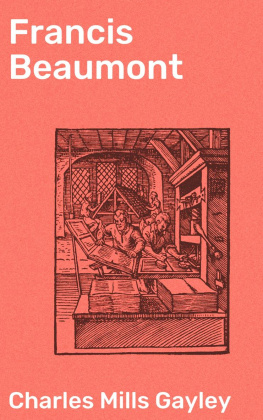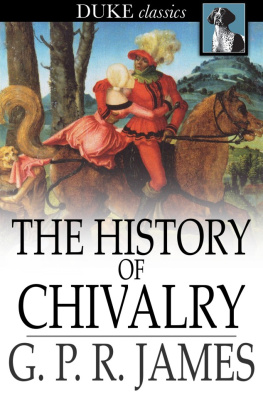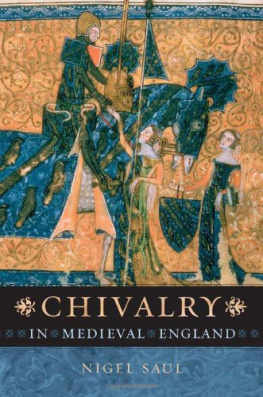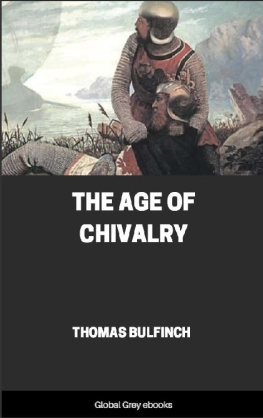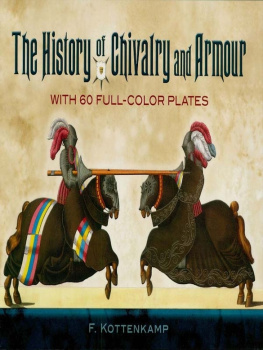PREFACE.
Table of Contents
The propriety of my writing a History of Chivalry, as a companion to my History of the Crusades, was suggested to me by a friend whose acquaintance with middle-age lore forms but a small portion of his literary attainments, and whose History of Italy shows his ability of treating, as well as his skill in discovering, subjects not hitherto discussed with the fulness which their importance merits.[1]
The works of Menestrier and Colombiere sleep in the dust of a few ancient libraries; and there are only two other books whose express and entire object is a delineation of the Institutions of chivalry. The first and best known is the French work called Mmoires sur lancienne Chevalerie; considre comme un Etablissement Politique et Militaire. Par M. de la Curne de Sainte Palaye, de lAcadmie Franoise, &c. 2 tom. 12mo. Paris, 1759. The last half, however, of the second volume does not relate to chivalry, and therefore the learned Frenchman cannot be charged with treating his subject at very great length.[2] It was his purpose to describe the education which accomplished the youth for the distinction of knighthood, and this part of his work he has performed with considerable success. But he failed in his next endeavour, that of painting the martial games of chivalry, for nothing can be more unsatisfactory than his account of jousts and tournaments. As he wished to inform his readers of the use which was made in the battle field of the valour, skill, and experience of knights, a description of some of the extraordinary and interesting battles of the middle ages might have been expected. Here also disappointment is experienced; neither can any pleasure be derived from perusing his examination of the causes which produced the decline and extinction of chivalry, and his account of the inconveniences which counterbalanced the advantages of the establishment.
Sainte Palaye was a very excellent French antiquarian; but the limited scope of his studies disqualified him from the office of a general historian of chivalry. The habits of his mind led him to treat of knighthood as if it had been the ornament merely of his own country. He very rarely illustrates his principles by the literature of any other nation, much less did he attempt to trace their history through the various states of Europe. He has altogether kept out of sight many characteristic features of his subject. Scarcely any thing is advanced about ancient armour; not a word on the religious and military orders; and but a few pages, and those neither pleasing nor correct, on woman and lady-love. The best executed part of his subject regards, as I have already observed, the education of knights; and he has scattered up and down his little volume and a half many curious notices of ancient manners.
The other work is written in the German language, and for that reason it is but very little known in this country. It is called Ritterzeit und Ritterwesen, (two volumes octavo, Leipzig, 1823,) and is the substance of a course of lectures on chivalry delivered by the author, Mr. Bsching, to his pupils of the High School at Breslau. The style of the work is the garrulous, slovenly, ungrammatical style which lecturers, in all countries, and upon all subjects, think themselves privileged to use. A large portion of the book is borrowed from Sainte Palaye; much of the remainder relates to feudalism and other matters distinct from chivalry: but when the writer treats of the state of knighthood in Germany I have found his facts and observations of very great value.
Attention to the subjects of the middle ages of Europe has for many years been growing among us. It was first excited by Wartons history of our national verse, and Percys edition of the Relics of ancient English Poetry. The romances of chivalry, both in prose and metre, and the numberless works on the Troubadour, and every other description of literature during the middle ages which have been published within the last few years, have sustained the interest. The poems of Scott convinced the world that the chivalric times of Europe can strike the moral imagination as powerfully and pleasingly in respect of character, passion, and picturesqueness of effect, as the heroic ages of Greece; and even very recently the glories of chivalry have been sung by a poetess whom Ariosto himself would have been delighted to honour.[3] Still, however, no attempt has been hitherto made to describe at large the institutions of knighthood, the foundation of all that elegant superstructure of poetry and romance which we admire, and to mark the history of chivalry in the various countries of Europe. Those institutions have, indeed, been allowed a few pages in our Encyclopdias; and some of the sketches of them are drawn with such boldness and precision of outline that we may regret the authors did not present us with finished pictures. Our popular historians have but hastily alluded to the subject; for they were so much busied with feudalism and politics, that they could afford but a small space for the play of the lighter graces of chivalry.
For a description, indeed, of antique manners, our materials are not so ample as for that of their public lives. But still the subject is not without its witnesses. The monkish chroniclers sometimes give us a glimpse of the castles of our ancestors. Many of the knights in days of yore had their biographers; and, for the most interesting time of chivalry, we possess an historian, who, for vividness of delineation, kindliness of feeling, and navet of language, is the Herodotus of the middle ages.
Did you ever read Froissart?
No, answered Henry Morton.
I have half a mind, rejoined Claverhouse, to contrive that you should have six months imprisonment, in order to procure you that pleasure. His chapters inspire me with more enthusiasm than even poetry itself.
Froissarts[4] history extends from the year 1316 to 1400. It was begun by him when he was twenty years old, at the command of his dear lord and master, Sir Robert of Namur, Lord of Beaufort. The annals from 1326 to 1356 are founded on the Chronicles compiled by him whom he calls The Right Reverend, discreet, and sage Master John la Bele, sometime canon in St. Lambertis of Liege, who with good heart and due diligence did his true devoir in writing his book; and heard of many fair and noble adventures from his being well beloved, and of the secret counsel of the Lord Sir John of Hainault. Froissart corrected all this borrowed matter on the information of the barons and knights of his time regarding their families gestes and prowesses. He is the chronicler both of political events and of chivalric manners. Of his merits in the first part of his character it falls not within my province to speak. For the office of historian of chivalry no man could present such fair pretensions. His father being a herald-painter, he was initiated in his very early years into that singular form of life which he describes with such picturesque beauty. Well I loved, as he says of his youth, in one of his poems, to see dances and carolling, and to hear the songs of minstrels and tales of glee. It pleased me to attach myself to those who took delight in hounds and hawks. I was wont to toy with my fair companions at school, and methought I had the art well to win the grace of maidens.My ears quickened at the sound of opening the wine-flask, for I took great pleasure in drinking, and in fair array, and in fresh and delicate viands. I loved to see (as is reason) the early violets, and the white and red roses, and also chambers brilliantly lighted; dances and late vigils, and fair beds for my refreshment; and for my better repose, I joyously quaffed a night-draught of claret, or Rochelle wine mingled with spice.




